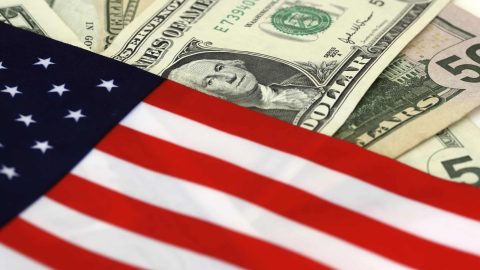A young father is always pressed for time. What he needs is in particular is a good strategy. One of my strategies in selecting reading material is to just wait. Time will tell what is interesting and what is not. Which is why last week I read a book that had come out in 2011: Exorbitant Privilege: The Rise and Fall of the Dollar, by Barry Eichengreen, ( an acclaimed) professor of economic history.
From my point of view, the book is worth reading and fits our times. It discusses the often-predicted end of the US dollar as worldwide lead currency and its resulting depreciation. Since the book was published, the US dollar has appreciated by about 35% (half of it over the past 15 months), weighted relative to all its trading partners and adjusted for differences in inflation.
What makes Eichengreen’s book so exciting is the arguments he relied on in 2011. He put forth the hypothesis that the end of the “preposterous privilege” ((©Valéry Giscard d’Estaing) was not imminent, despite all prophecies of doom. Well-versed economist and teacher that Eichengreen is, he based his statement on an easily readable and historically well-grounded analysis. I would like to focus on a few specific points here that I regard as interesting for the situation we are currently in.
Being the global lead currency is fun:
it allows you to produce something at basically zero cost, and yet everyone wants to have it. You can live beyond your means for some time (external trade deficits) and finance this habit cheaply, given that the demand for your own securities, especially government/Treasury bonds, is massive. You can create a number of well-paid jobs from this privilege (N.B. this was a positive statement about the financial industry), and you can make others dance to the beat of your drum since they depend on you (that is, they need your currency). No surprise therefore that others (=China) want to be in that position.
The global economy became much more robust with flexible exchange rates.
The time of fixed exchange rates (gold standard before and after WWI, limited convertibility prior to WWII, and as a result of Bretton Woods after the War) was a period when minimal changes in the exchange rate would trigger massive turbulences of the economy. If we compare it to the movement of the euro since its introduction vis-à-vis the US dollar (start at 1.18, down to 0.82, up to 1.60, and back down to currently 1.1), we can see how much more robust the global economy has become on the back of flexible exchange rates. This also manifests itself today wherever exchange rates are still fixed. The two devaluations in China this year of about 4.5% triggered massive spikes on the markets.
Currencies and exchange rates have always also been political issues.
Devaluations have brought about the downfall of governments. In the Suez crisis of 1956 the Americans were blackmailing the British on the currency front until the Eden cabinet retreated from the Suez Canal. This is only one such story of many that we could find in history. The political aspect of currencies is older than the euro and has not only facilitated the creation of the euro (with the German reunification constituting a window of opportunity), but also necessitated it (France was losing face due to repeated depreciation relative to the D-mark). Currencies have always been political symbols, which means that it is difficult to accuse the euro of all currencies to be just a political project.
Today the often-scolded euro is at least a local lead currency.
This is reflected in the extent to which the euro is used as reserve currency by various central banks, by how many countries trade in euro (even if they do not use the euro as currency), by how many countries have joined the Eurozone after the euro crisis, and by how many countries make use of the euro without being part of the Eurozone. To paraphrase Mark Twain: the reports of the death of the euro have been greatly exaggerated.
Both the British pound and the US dollar have repeatedly been exposed to discussions about their status as lead currency. And every time capital flows out of these large capital markets the outflow comes with repercussions on those new destinations the capital is flowing into. Prior to the introduction of the euro it was the D-mark that for a long time was going up and down with the tides of the capital flows of the US dollar, much like a tiny boat on the Ocean. Today the Swiss franc comes to mind, which in the past years has “benefited” from the massive flows from the euro.
The US dollar is lead currency.
A large part of global trade is invoiced in US dollar, even if nobody from the USA is involved. This means that the Fed is not only the central bank of the USA, but also the central bank of the world. There used to be a small difference between the two, since the USA would produce a larger share of global GDP, as a result of which the key-lending rates set by the Fed in relation to the US economy were a better fit for the global economic activity. However, in the meantime this relationship has loosened significantly. If the key-lending rates (i.e. the Fed funds rate) is up in the US, this may suit the US economy, but it may be a bad fit for the global economy. This is one of the reasons why emerging economies that depend on the US dollar are currently having such a hard time.
Prior to the US dollar, the British pound used to be the lead currency of the world. Trade transactions were invoiced in pounds, international loans were granted in pounds, and the UK benefited from everything that the status of a lead currency would provide it with. However, the UK lost its status within a relatively short period of time. Eichengreen points out that the pound lost its role to the US dollar within only tens years, which to me suggests that it is worthwhile monitoring closely the current efforts to develop a market for the renminbi and to expand Shanghai into a worldwide financial centre.
After WWII the dollar was the (only) lead currency because it was freely convertible, supported by an enormous economic power (about 50% of the economic output outside the Communist Bloc was produced by the USA), and protected by extremely liquid and deep capital markets. By comparison, the euro lacks the adequate capital market, while China lacks both the capital market and the convertibility of its currency. Thus it is clear that the US dollar will remain the lead currency.
Europe would have to broaden and deepen its capital market (i.e. the role of the banks in financing; Eurobonds; capital transaction tax etc). China, on the other hand, would have to continue its efforts to liberalise the capital market and to develop a renminbi capital market for foreign investors.
Exorbitant Privilege: The Rise and Fall of the Dollar clearly shows that exchange rates follow fundamental developments and cannot de-couple forever from the facts presented by such fundamentals. Facts change, and as a result, exchange rates change, too. With flexible exchange rates, this adjustment happens step by step and causes less cost. From my perspective, the most recent “big” revolution was the fact that in the past 15 months a further discrepancy between the central bank policies in the USA and in Europe has become foreseeable. In the USA the zero percent interest rate policy will soon come to an end. In Europe, further steps of monetary loosening can be expected. This is exactly what has also been reflected in the EUR-USD exchange rate in the past months. I believe that this development has meanwhile made it to the markets and will not cause the euro to depreciate massively anymore (unless the US Fed increases its rates much more quickly than anticipated). Intuitively, the risk has now shifted to the other side, given that the rate hike in the USA has been pushed back repeatedly.
To sum up, I would predict that the US dollar will be the global lead currency also ten years from now, but at the same time we will see a group of currencies that will hold a more important regional status. Among them will be the Chinese renminbi and the euro.
Legal disclaimer
This document is an advertisement. Unless indicated otherwise, source: Erste Asset Management GmbH. The language of communication of the sales offices is German and the languages of communication of the Management Company also include English.
The prospectus for UCITS funds (including any amendments) is prepared and published in accordance with the provisions of the InvFG 2011 as amended. Information for Investors pursuant to § 21 AIFMG is prepared for the alternative investment funds (AIF) administered by Erste Asset Management GmbH pursuant to the provisions of the AIFMG in conjunction with the InvFG 2011.
The currently valid versions of the prospectus, the Information for Investors pursuant to § 21 AIFMG, and the key information document can be found on the website www.erste-am.com under “Mandatory publications” and can be obtained free of charge by interested investors at the offices of the Management Company and at the offices of the depositary bank. The exact date of the most recent publication of the prospectus, the languages in which the fund prospectus or the Information for Investors pursuant to Art 21 AIFMG and the key information document are available, and any other locations where the documents can be obtained are indicated on the website www.erste-am.com. A summary of the investor rights is available in German and English on the website www.erste-am.com/investor-rights and can also be obtained from the Management Company.
The Management Company can decide to suspend the provisions it has taken for the sale of unit certificates in other countries in accordance with the regulatory requirements.
Note: You are about to purchase a product that may be difficult to understand. We recommend that you read the indicated fund documents before making an investment decision. In addition to the locations listed above, you can obtain these documents free of charge at the offices of the referring Sparkassen bank and the offices of Erste Bank der oesterreichischen Sparkassen AG. You can also access these documents electronically at www.erste-am.com.
Our analyses and conclusions are general in nature and do not take into account the individual characteristics of our investors in terms of earnings, taxation, experience and knowledge, investment objective, financial position, capacity for loss, and risk tolerance. Past performance is not a reliable indicator of the future performance of a fund.
Please note: Investments in securities entail risks in addition to the opportunities presented here. The value of units and their earnings can rise and fall. Changes in exchange rates can also have a positive or negative effect on the value of an investment. For this reason, you may receive less than your originally invested amount when you redeem your units. Persons who are interested in purchasing units in investment funds are advised to read the current fund prospectus(es) and the Information for Investors pursuant to § 21 AIFMG, especially the risk notices they contain, before making an investment decision. If the fund currency is different than the investor’s home currency, changes in the relevant exchange rate can positively or negatively influence the value of the investment and the amount of the costs associated with the fund in the home currency.
We are not permitted to directly or indirectly offer, sell, transfer, or deliver this financial product to natural or legal persons whose place of residence or domicile is located in a country where this is legally prohibited. In this case, we may not provide any product information, either.
Please consult the corresponding information in the fund prospectus and the Information for Investors pursuant to § 21 AIFMG for restrictions on the sale of the fund to American or Russian citizens.
It is expressly noted that this communication does not provide any investment recommendations, but only expresses our current market assessment. Thus, this communication is not a substitute for investment advice.
This document does not represent a sales activity of the Management Company and therefore may not be construed as an offer for the purchase or sale of financial or investment instruments.
Erste Asset Management GmbH is affiliated with the Erste Bank and austrian Sparkassen banks.
Please also read the “Information about us and our securities services” published by your bank.


